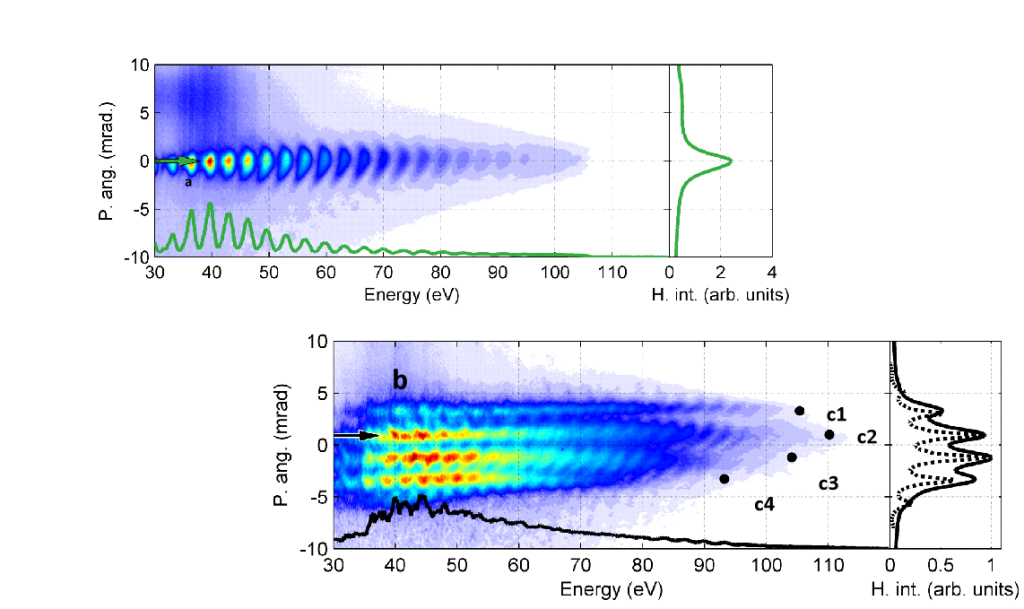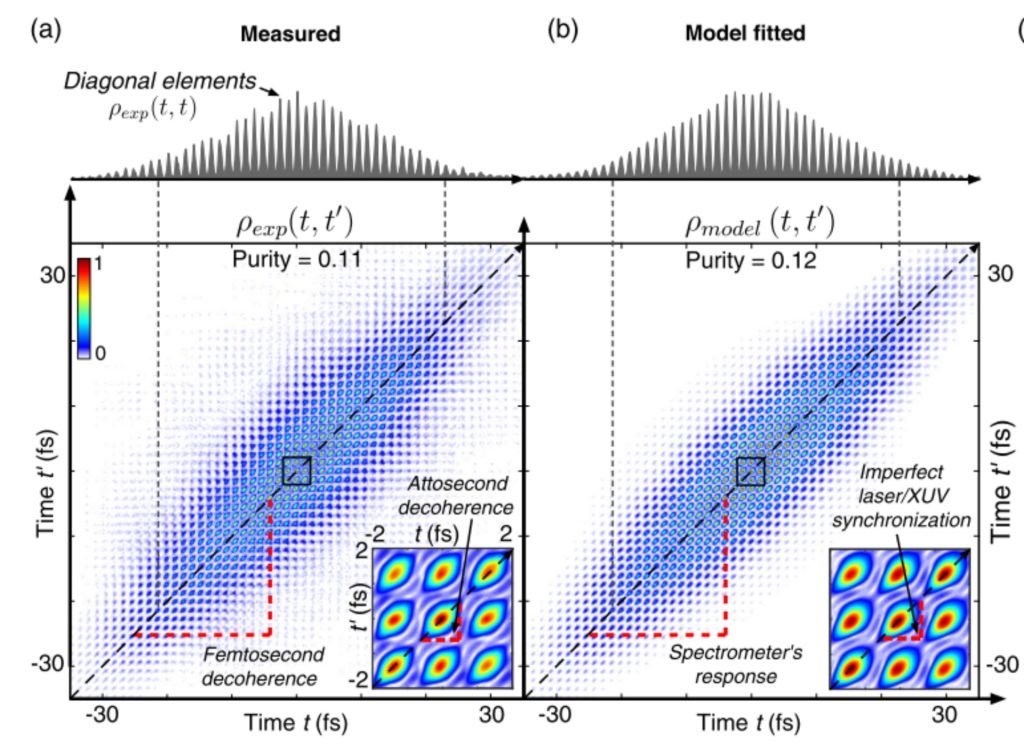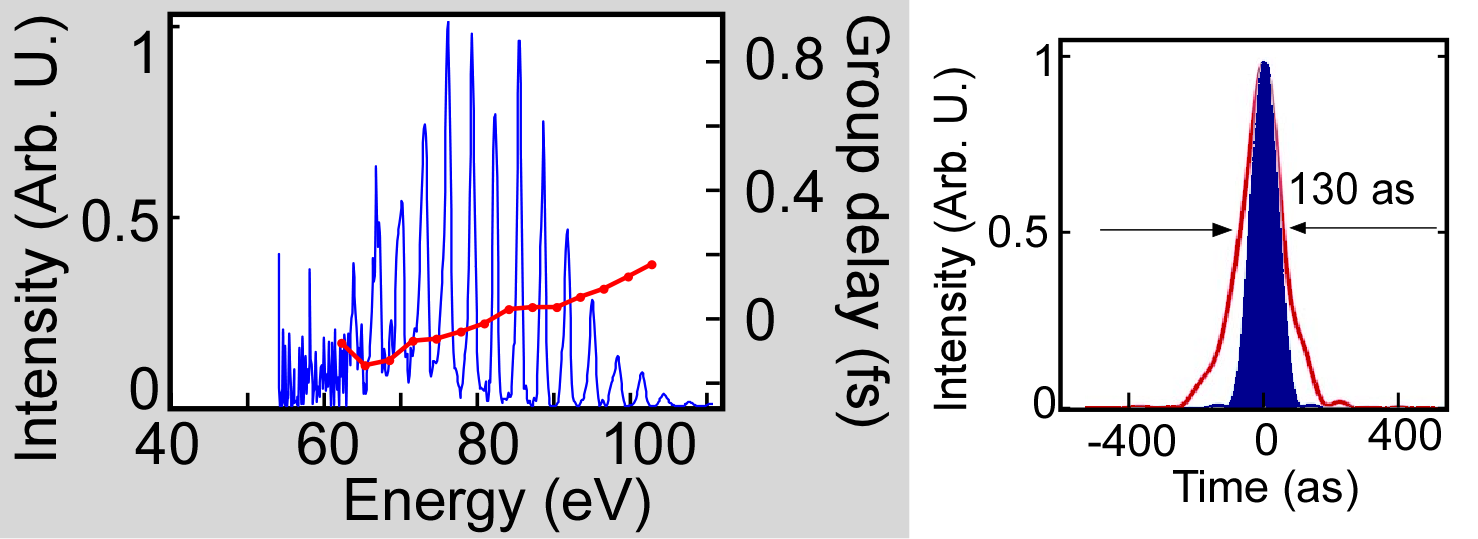
Thierry Ruchon’s research pages
Quantifying dechorence in attosecond metrology
The hypothesis of a full coherence is implicit to all measurement techniques of attosecond light pulses. This is in particular valid for the most popular techniques, namely FROG-CRAB/Streaking and RABBITT. Any source of decoherence, may it come from the measurement itself or intrinsic to the photoionization process, is not considered.
In a collaboration with Charles Bourassin-Bouchet from Laboratoire Charles Fabry (Institut d’Optique Graduate School, Palaiseau), we could extend the RABBITT technique to a so-called « mixed-FROG » configuration. By increasing the dressing energy to allow the formation of sidebands from any combination of harmonics in a spectrum, we are able to measure all their relative coherence and reconstruct their complex Wigner matrix. In our test case, we could show that the purity of our attosecond source was only 0.11, and that the main source of decoherence came from the measurement line and delays fluctuations in the RABBITT interferometer. Importantly, we could also show that the RABBITT technique reconstructs only the coherent part of this complex source. These results open an avenue to the measurement of coherence in complex photoionization processes in atoms and molecules.
Attosecond light house in gases

Related publications :
The HHG process driven by a multi-cycle laser pulse happens any time the electric field is sufficient to tunnel ionize an outermost electron of the target atom. The result, with 5-10 fs long pulses is the emission of a train of attosecond pulses, separated by half the period of the driving laser, i.e 1.3 fs with our Ti: Sapphire lasers. In quite many applications it is desirable to isolate the light emission from a single half cycle. This may be useful to analyse the radiation in highly non linear spectroscopy schemes as well as for pump-probe XUV-IR experiments (see XUV spectroscopy page).
To overcome the limitations raised by the use of multicycle laser pulses, Henri Vincenti and Fabien Quéé propose to finely tailor the spatio-temporal shape of a 5-10 s laser pulse Vincenti et al., Phys. Rev. Lett. 108, 113904 (2012) . Imposing a wavefront rotation, they theoretically showed that themission from successive half cycles should be angularly separated. We could demonstrate experimentally this prediction through a collaboration with our canadian colleagues from NRC (attoscience.ca ).
Attosecond pulse shaping with mirrors

Related publications :
When generating high order harmonics, the synchronization of the different wavelengths is not perfect. In practical conditions, there is a phase shift corresponding to about 80-100 as between two successive harmonics generated in argon with our standard 800 nm wavelength Ti: Sapphire laser. This may be reduced down to about 30 as when generating in neon. This lack of synchronism between different harmonics degrades the temporal structure of the attosecond pulses.
Through a collaboration with our colleagues from Institut d’Optique Graduate School, we designed and tested multilayer mirrors that allow the compression of high order harmonics over 20 eV, with a central energy of 30eV. We also proposed to use them as a pulse shaper, taking advantage of the sensitivity of the phase they add to the harmonic when tuning their incidence angle.
Attosecond pulse shaping with filters (work carried out in Lund)
TAttosecond pulses are not naturally best compressed when getting out of a generating cell. Following the first experiments of Lopez-Martens et al., we used several combinations of filters to get extremely well compressed pulses. Indeed, generating harmonics in neon and filtering them with 200nm thick Zirconium filters we measured attosecond pulses of 130 as duration.



